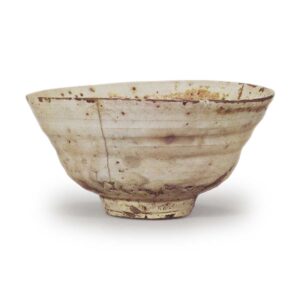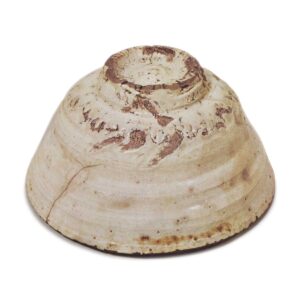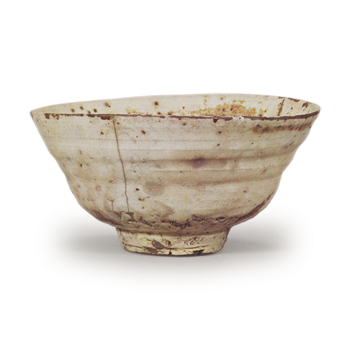

Important Cultural Property
Held by: Nezu Museum
Height: 7.5-8.2cm
Diameter: 15.9cm
Base diameter: 5.5cm
Height: 1.5cm
As is recorded in the account books of the Himeji Sakai family, this is a “kogente ame-nure” (leaky old-fashioned tea bowl). The term “ame-nure” is often used to refer to kogente, but today it is not necessarily limited to kogente, and it can also be used to refer to kumagawa or kohiki, in other words, if there are any spots on the surface, it can be called ame-nure.
Kogente has one particular characteristic. The finished product is rough and unpolished, with a total glaze that is not hard and brittle, and the finish is free and unrestrained, similar to earthenware such as wells, with a free-form wheel-throwing finish. The foot ring is like a bamboo joint, the glaze is thick and soft, and the glaze surface is not very shiny, with a purple tinge.
In this respect, the Amamori teacup that has been handed down in the Sakai family is a typical example of Ko-Kente, and it truly stands out among similar bowls. It is probably safe to say that there is only one Ko-Kente teacup in the world with such a high level of workmanship. The workmanship has the same style as the famous Oido bowls, and while it is made from a slightly thin clay, the rough texture of the clay is evident in the body, which has been turned on the wheel several times, and the body shows a wonderful variation in speed and slowness. The bold, strong base of the bowl tapers to a barrel-shaped foot, giving it a strong sense of power. The two vertical cracks are also impressive and add a certain kind of beauty. The thickly glazed, translucent skin of the inside and outside of the vessel is like the skin of a soft white gem, and the gradations of the glaze and uneven glaze show the extremes of change. The rough surface of the clay on the side of the foot ring is glazed particularly thickly, or it is glazed in a way that resembles the skin of a Japanese apricot, or it is glazed unevenly, or the fire marks are shown. The inside of the foot ring is polished to show the clay, and the tatami mat is also polished. The effect of the clay showing through the foot ring and around the side is nothing short of magnificent.
On the glaze surface, purple spots seem to be floating like a dream, between the rhythmic marks of the potter’s wheel. The purple spots are even darker around the inside, scattered in various places. The inside of the bowl is particularly thickly glazed, and looks like a lump of hardened fat, but within this, there are four elegant eyes. There is lacquer repair on the rim in several places.
The old Kantei itself is already a rare relic, but this tea bowl in particular is thought to be from the very beginning of the Yi Dynasty, and is not only a valuable tea bowl, but also a rare relic of Yi Dynasty white porcelain that is worthy of great respect.
Box, lid, inscription by Sasaki Bunzan “Koryo teacup with a leak”
It was in the Himeji Sakai family’s possession from the Edo period, and was passed on to Nezu Aoyama (Kaichiro) in the Taisho period, and became a Nezu Museum collection in 1941 when the museum was established.



